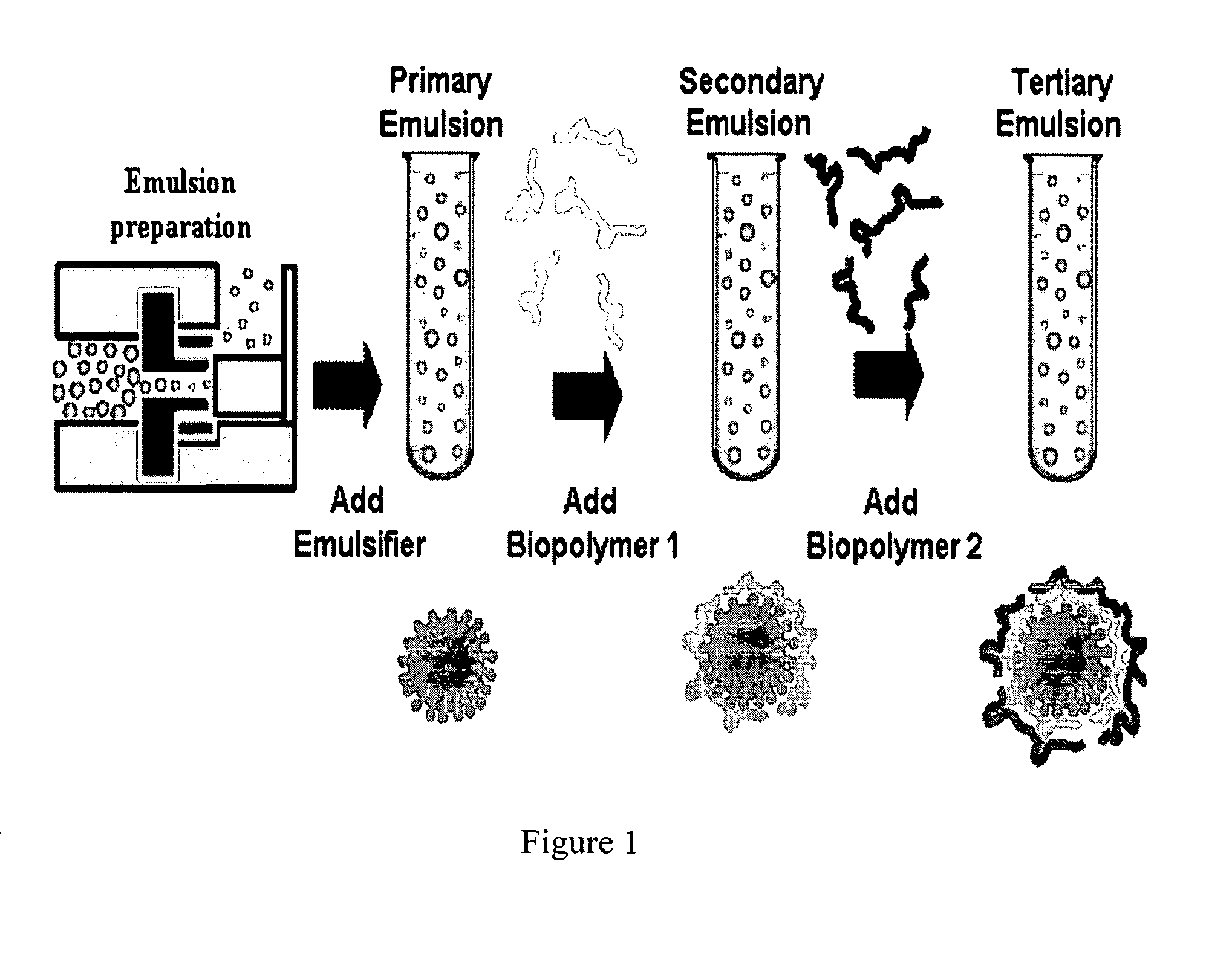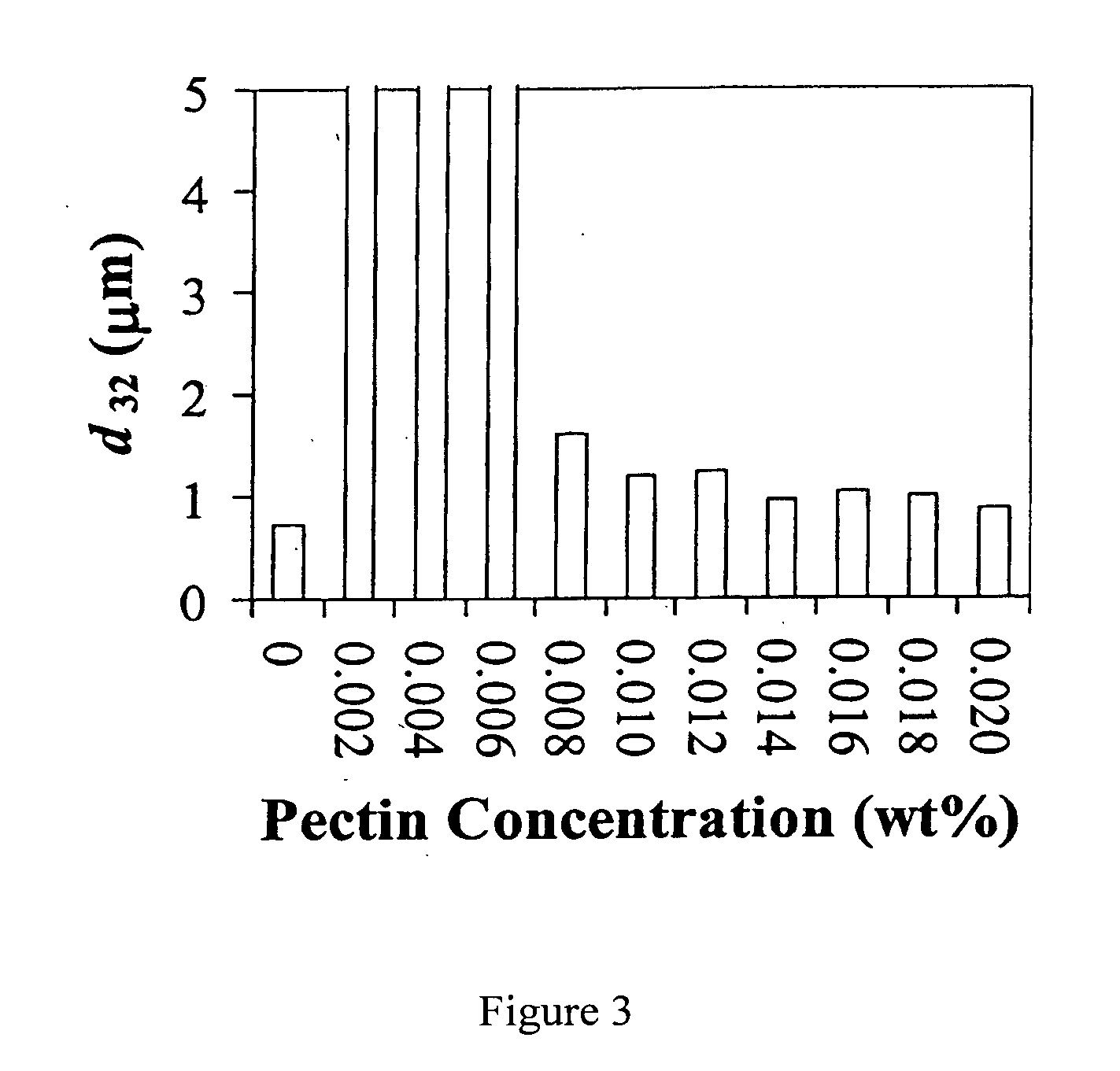Biopolymer encapsulation and stabilization of lipid systems and methods for utilization thereof
a biopolymer and lipid system technology, applied in the field of lipid components, can solve the problems of large economic burden on society as a whole, major deterioration in the quality of life of individuals involved, and variety of human health problems, so as to reduce digestible fat and caloric content, improve taste, appearance, texture and stability of products, and facilitate substitution
- Summary
- Abstract
- Description
- Claims
- Application Information
AI Technical Summary
Benefits of technology
Problems solved by technology
Method used
Image
Examples
example 1
[0051] Emulsion preparation. A primary emulsion was prepared by homogenizing 5 wt % corn oil with 95 wt % aqueous emulsifier solution in a high-speed blender (M133 / 1281-0, Biospec Products, Inc., ESGC, Switzerland) followed by two passes at 4,000 psi through a two-stage high-pressure valve homogenizer (LAB 1000, APV-Gaulin, Wilmington, Mass.). A secondary emulsion was prepared by mixing the primary emulsion with appropriate amounts of chitosan solution and buffer solution to obtain a final concentration of 1 wt % corn oil, 0.2 wt % lecithin, 0.0155 wt % chitosan, 100 mM acetic acid (pH 3.0). These systems were stirred for 1 hour using a magnetic stirrer at ambient temperature. The flocs formed in this emulsion were disrupted by passing it twice through a high pressure value homogenizer at a pressure of 4000 psi, as described previously (8, 9). Tertiary emulsions were formed by diluting the secondary emulsion with aqueous pectin solutions to produce a series of emulsions with differe...
example 2a
[0052] Influence of pectin concentration on droplet charge. The electrical charge and mean droplet diameter of tertiary emulsions (0.5 wt % corn oil, 0.1 wt % lecithin, 0.0078 wt % chitosan, 100 mM acetic acid, pH 3.0) containing different pectin concentrations (0 to 0.02 wt %) was measured. In the absence of chitosan, the electrical charge on the secondary emulsion droplets was +30 mV (FIG. 2), indicating that the lecithin-chitosan membrane had a relatively high positive charge at pH 3. The electrical charge on the droplets became increasingly less positive, and eventually changed from positive to negative as the pectin concentration in the emulsions was increased (FIG. 2). There was no net charge on the droplets when the pectin concentration was around 0.003 wt %, indicating that sufficient pectin had adsorbed to neutralize the charge on the original droplets. The negative charge on the droplets reached a constant value of −14 mV when the pectin concentration exceeded about 0.01 w...
example 2b
[0053] Influence ofpectin concentration on particle size. The mean particle diameter of tertiary emulsions was measured 24 hours after pectin was mixed with the secondary emulsions (FIG. 3). The emulsion was stable to droplet aggregation in the absence of pectin. At pectin concentrations from 0.002 to 0.006 wt % extensive droplet aggregation was observed in the emulsions. Droplet aggregation was so extensive that we were unable to make reliable particle sizing measurements using the laser diffraction technique, either because the aggregates were too large or because their concentration was too small to give a scattering pattern that was sufficiently different from that of the background. Individual particles within these samples could be distinctly observed by eye, which suggested that they were at least 100 μm in diameter.
[0054] The origin of the extensive droplet flocculation in these emulsions is believed to be two-fold. First, the magnitude of the net electrical charge on the d...
PUM
 Login to View More
Login to View More Abstract
Description
Claims
Application Information
 Login to View More
Login to View More - R&D
- Intellectual Property
- Life Sciences
- Materials
- Tech Scout
- Unparalleled Data Quality
- Higher Quality Content
- 60% Fewer Hallucinations
Browse by: Latest US Patents, China's latest patents, Technical Efficacy Thesaurus, Application Domain, Technology Topic, Popular Technical Reports.
© 2025 PatSnap. All rights reserved.Legal|Privacy policy|Modern Slavery Act Transparency Statement|Sitemap|About US| Contact US: help@patsnap.com



